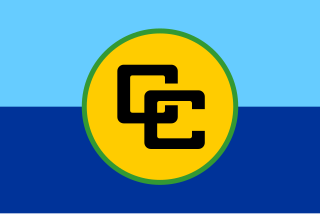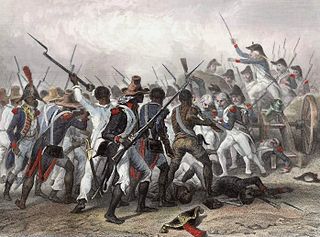
Montserrat is a British Overseas Territory in the Caribbean. It is part of the Leeward Islands, the northern portion of the Lesser Antilles chain of the West Indies. Montserrat is about 16 km (10 mi) long and 11 km (7 mi) wide, with roughly 40 km (25 mi) of coastline. It is nicknamed "The Emerald Isle of the Caribbean" both for its resemblance to coastal Ireland and for the Irish ancestry of many of its inhabitants. Montserrat is the only non-fully sovereign full member of the Caribbean Community and the Organisation of Eastern Caribbean States.

The Caribbean Community is an intergovernmental organisation that is a political and economic union of 15 member states throughout the Caribbean. They have primary objectives to promote economic integration and cooperation among its members, ensure that the benefits of integration are equitably shared, and coordinate foreign policy. The organisation was established in 1973, with its four founding members signing the Treaty of Chaguaramas. Its primary activities involve:
Jamaican English, including Jamaican Standard English, is a variety of English native to Jamaica and is the official language of the country. A distinction exists between Jamaican English and Jamaican Patois, though not entirely a sharp distinction so much as a gradual continuum between two extremes. Jamaican English tends to follow British English spelling conventions.

The Antilles is an archipelago bordered by the Caribbean Sea to the south and west, the Gulf of Mexico to the northwest, and the Atlantic Ocean to the north and east.
Caribbean English is a set of dialects of the English language which are spoken in the Caribbean and Liberia, most countries on the Caribbean coast of Central America, and Guyana and Suriname on the coast of South America. Caribbean English is influenced by, but is distinct to, the English-based creole languages spoken in the region. Though dialects of Caribbean English vary structurally and phonetically across the region, all are primarily derived from British English and West African languages. In countries with a plurality Indian population, such as Trinidad and Tobago and Guyana, Caribbean English has further been influenced by Hindustani and other South Asian languages.

Jamaican Patois is an English-based creole language with West African influences, spoken primarily in Jamaica and among the Jamaican diaspora. A majority of the non-English words in Patois come from the West African Akan language. It is spoken by the majority of Jamaicans as a native language.
Nigerian Pidgin, also called Naijá or Naija, is an English-based creole language spoken as a lingua franca across Nigeria. The language is sometimes referred to as "Pijin" or Broken. It can be spoken as a pidgin, a creole, slang or a decreolised acrolect by different speakers, who may switch between these forms depending on the social setting. In the 2010s, a common orthography was developed for Pidgin which has been gaining significant popularity in giving the language a harmonized writing system.

The Sierra Leonean Creole or Krio is an English-based creole language that is lingua franca and de facto national language spoken throughout the West African nation of Sierra Leone. Krio is spoken by 96 percent of the country's population, and it unites the different ethnic groups in the country, especially in their trade and social interaction with each other. Krio is the primary language of communication among Sierra Leoneans at home and abroad, and has also heavily influenced Sierra Leonean English. The language is native to the Sierra Leone Creole people, or Krios, a community of about 104,311 descendants of freed slaves from the West Indies, Canada, United States and the British Empire, and is spoken as a second language by millions of other Sierra Leoneans belonging to the country's indigenous tribes. English is Sierra Leone's official language, and Krio, despite its common use throughout the country, has no official status.
Antiguan and Barbudan Creole, often called Creole, "Local dialect", or simply Antiguan and Barbudan is an English-based creole language consisting of several varieties spoken in the Leeward Islands, namely the countries of Antigua and Barbuda, Saint Kitts and Nevis and the British territories of Anguilla and Montserrat.
Saint Kitts Creole is a dialect of Leeward Caribbean Creole English spoken in Saint Kitts and Nevis by around 40,000 people. Saint Kitts Creole does not have the status of an official language.
Anguillan Creole is a dialect of Leeward Caribbean Creole English spoken in Anguilla, an island and British Overseas Territory in the Caribbean. Although classified as a dialect of Leeward Caribbean Creole English spoken in Saint Kitts and Nevis, Antigua and Montserrat due to a common British colonial history, it is actually closer to the British Virgin Islands and Saint Martin varieties of Virgin Islands Creole. The number of speakers of Anguillan Creole is below 10,000. Anguillan Creole does not have the status of an official language.
Mískito Coast Creole or Nicaragua Creole English is an English-based creole language spoken in coastal Nicaraguan region of Mosquito Coast on the Caribbean Sea; its approximately 18,000 speakers are spread over a number of small villages. The region is today administratively separated into two autonomous regions: North Caribbean Coast and South Caribbean Coast. Mosquito is the nickname that is given to the region and earlier residents by early Europeans who visited and settled in the area. The term "Miskito" is now more commonly used to refer to both the people and the language.
Guyanese English Creole is an English-based creole language spoken by the Guyanese people. Linguistically, it is similar to other English dialects of the Caribbean region, based on 19th-century English and has loan words from African, Indian, Arawakan, and older Dutch languages.
Caribbean literature is the literature of the various territories of the Caribbean region. Literature in English from the former British West Indies may be referred to as Anglo-Caribbean or, in historical contexts, as West Indian literature. Most of these territories have become independent nations since the 1960s, though some retain colonial ties to the United Kingdom. They share, apart from the English language, a number of political, cultural, and social ties which make it useful to consider their literary output in a single category. The more wide-ranging term "Caribbean literature" generally refers to the literature of all Caribbean territories regardless of language—whether written in English, Spanish, French, Hindustani, or Dutch, or one of numerous creoles.
An English-based creole language is a creole language for which English was the lexifier, meaning that at the time of its formation the vocabulary of English served as the basis for the majority of the creole's lexicon. Most English creoles were formed in British colonies, following the great expansion of British naval military power and trade in the 17th, 18th and 19th centuries. The main categories of English-based creoles are Atlantic and Pacific.

The Caribbean is a region of the Americas that consists of the Caribbean Sea, its islands and the surrounding coasts. The region is southeast of the Gulf of Mexico and the North American mainland, east of Central America, and north of South America.
Cayman Islands English is an English variety spoken in the Cayman Islands. While not much has been written on Cayman Islands English, according to one text, it "seems to have borrowed creole features similar to Jamaica and Central America without having undergone creolization". It is similar to Bay Islands English. African-American vernacular English and Jamaican Patois have also influenced the way younger Caymanians speak.

The Sierra Leone Creole people are an ethnic group of Sierra Leone. The Sierra Leone Creole people are descendants of freed African-American, Afro-Caribbean, and Liberated African slaves who settled in the Western Area of Sierra Leone between 1787 and about 1885. The colony was established by the British, supported by abolitionists, under the Sierra Leone Company as a place for freedmen. The settlers called their new settlement Freetown. Today, the Sierra Leone Creoles are 1.2 percent of the population of Sierra Leone.
The Gambian Creole people, or Krio or Aku, are a minority ethnic group of Gambia with connections to and roots from the Sierra Leone Creole people. In Gambia the Aku account for about 2% of the population. Some estimates put the figure higher. However, according to the 2013 Gambian Census, the Aku make up 0.5% of the population or around 8,477 people.

The Montserrat slave rebellion of 1768 was an unsuccessful slave rebellion in the English colony of Montserrat in the Caribbean Sea that took place on 17 March 1768.







